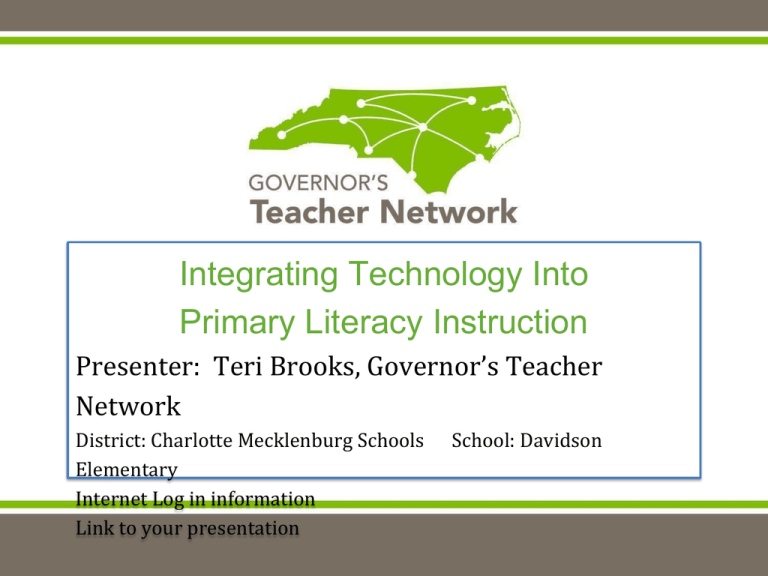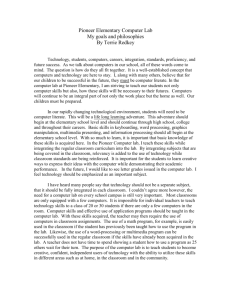Integrating Technology Into Primary Literacy Instruction Presenter: Teri Brooks, Governor’s Teacher Network
advertisement

Integrating Technology Into Primary Literacy Instruction Presenter: Teri Brooks, Governor’s Teacher Network District: Charlotte Mecklenburg Schools Elementary Internet Log in information Link to your presentation School: Davidson What is the Governor’s Teacher Network? • A talented group of 450 outstanding teachers were selected from 1400 applicants for 2014-15. • Teachers identify instructional needs, create innovative digital instructional resources and design professional development to support key Race to the Top initiatives in Home Base. • Network Teachers continue their current educator roles in their schools and districts and serve in one of two pathways. Governor’s Teacher Network Pathway 1 Pathway 1 Teachers: Professional Development • Identify problems of practice around instructional needs and conduct action research projects in their schools. • Investigate and analyze the effectiveness of strategies and practices on student learning. • Create professional development sessions and materials to be posted in Schoolnet and the Professional Development System in Home Base. What is Action Research? Classroom and school research conducted by teachers to: • Positively impact student outcomes • Identify and promote effective instructional practices • Create opportunities for teachers to become reflective practitioners • Share research results with other educators Mills, Geoffrey E, Action Research: A Guide for the Teacher Researcher, 2014 Scope of Work •What is the problem of practice addressed? •Why is this important? •Who would benefit from these resources? •How will this benefit students and teachers? What is the problem of practice addressed? Many primary classrooms are filled with children who come to school with a deficit in "life" experiences, language abilities, and pre-reading and/or math skills. Coupled with the growing needs of primary students is the increase in high stakes testing and the reduction of teacher assistant allocations. Why is this important? We know that there is no substitute for a full-time, qualified teacher's assistant in every Kindergarten and First Grade classroom. In a perfect world each classroom would have the help needed to ensure success for each student. Often this is not the case and primary teachers need assistance to meet the needs of their students. Integrating technology in primary classrooms can support teachers as they work with young students who need one-on-one instruction. The iPad provides many quality apps and access to programs that can provide feedback to both the student and the teacher, mimicking the one-to-one tutoring that is often provided by a teaching assistant. The purpose of this study is to determine the impact of technology on increasing student engagement, stamina, and achievement. Who would benefit from these resources? * primary classroom teachers * primary students * academic facilitators * professional development trainers * administrators * local school and district level decision makers How will this research benefit students and teachers? Providing evidence that integrating technology into primary literacy instruction can increase student engagement/learning may encourage primary teachers to integrate technology into their classrooms to increase student achievement. Can integrating technology into primary reading and writing workshops increase student engagement, stamina, and achievement? Action Research Plan Research Findings Problems of Practice "Table Talk" •What types of technology are used in the elementary schools in your district and how are they used? •Do you have concerns as more technology is used in the elementary school setting? Concerns about implementation? Concerns about professional development? •Can integrating technology into primary reading instruction increase student engagement, stamina, and achievement? Knowmia presentation link References Spires, H. A., Lee, J. K., Turner, K. A., & Johnson, J. (2008). Having our say: Middle grade student perspectives on school, technologies, and academic engagement. Journal of Research on Technology in Education, 40(4), 497-515 Gibson, Jr., Lenwood, Cartledge, Gwendolyn, Keyes, Starr E. (2011). A preliminary investigation of supplemental computer-assisted reading instruction on the oral reading fluency and comprehension of first-grade African American urban students. Journal of Behavior Education, (2011) 20:260-282 DOI. 10.1007/s 10864-011 - 9136-7. Boeglin-Quintana, Brenda; Donovan, Loretta (2013). Storytime Using iPods: Using Technology to Reach All Learners. Tech Trends: Linking Research to Improve Learning. Nov 2013, Vol 57 Issue 6, p.49-56 Quigley, Donna (2011). Internet and independent e-learning of school age children in Thailand (one study). U.S.-China Education Review A6 (2011) 749-755 Kim, Paul; Hagashi, Teresita; Carillo, Laura; Gonzales, Irins; Makany, Tamas; Lee, Bommi; Garate, Alberto (2010). Socioeconomic strata mobile technology and education: a comparative analysis. Education Technology Research Development (2011) 59: 465486 DOI 10.007/s 11523-9172-3 Cviko, Amina; McKenney, Susan; Voogt, Joke (2012). teachers enacting a technologyrich curriculum for emergent literacy. Educational Technology Research and Development, Feb 2012, Vol60 Issue 1, p31-54 24p. Activity •iPad users - download one of the following free apps: Puppet Pals, Poplet, ChatterKids, or Padlet. • Laptop users - go to Symbaloo and type in DES Tigers Rock! Click on tiles to explore resources. •All - go to your local library website and click on the Tumblebooks link to explore these FREE eBooks. Discussion How is Schoolnet used? Research results will be housed on Schoolnet and on the GTN wiki. Questions •Questions? Feedback Insert link to feedback form to evaluate effectiveness of presentation. http://goo.gl/forms/nuhwNC6pyV Conclusion of Presentation •Thank you for your participation. Contact Information: Name: Teri Brooks School/District: Davidson Elementary/CMS Phone: 980-343-3900 Email: t.brooks@cms.k12.nc.us Website: http://teribrooks.cmswiki.wikispaces.net

